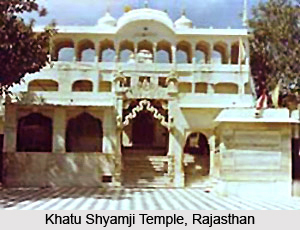 Khatu Shyamji Temple is an important pilgrimage site in Rajasthan. However it is more popular for the annual fair that takes in the month of either February or March. The shrine is located at a distance of 48 kilometers from district of Sikar. From Jaipur this site is easily accessible. The mela or fair takes place on the occasion of Phalgun Sudi Dashmi and lasts till Dwadashi. It lasts for three days and a large number of devotees flock the fair.
Khatu Shyamji Temple is an important pilgrimage site in Rajasthan. However it is more popular for the annual fair that takes in the month of either February or March. The shrine is located at a distance of 48 kilometers from district of Sikar. From Jaipur this site is easily accessible. The mela or fair takes place on the occasion of Phalgun Sudi Dashmi and lasts till Dwadashi. It lasts for three days and a large number of devotees flock the fair.
As is the case with Indian ceremonies this ceremony too is related to legends. It is said that when the battle of Kurukshetra (Mahabharata) was about to commence the grandson of Bhima (one of the Pandavas) expressed his desire to participate in the battle. Lord Krishna realized that if he took part in the battle the Pandavas would easily win because of his valor and justice will remain undelivered. So Krishna appeared in the disguise of a Brahmin and asked for Barbarik`s (Bhima`s grandson) head. Without any qualms he complied. Krishna was greatly moved by this sacrifice.
In return of this sacrifice he was blessed with 2 boons by the lord. He was able to witness the battle of Kurukshetra from a hilltop. He was also to be worshipped as Shyam. The name Shyam belongs to Lord Krishna himself. It was the result of the boon that even today people worship Khatu Shyamji.
Indian fairs are characterized by vitality, crowd and resplendence. Khatu Shyamji fair is no exception in this regard. Well-decorated shops, several kinds of shows and sweet tidbits are available for the visitors. Joy rides are also part of Khatu Shyamji fair in Rajasthan.
Architecture of Khatu Shyamji Temple
This temple is very rich in its architectural galore. Marble and lime motors have been extensively used in the constructing the structure. The shutter of sanctum sanctorum is very serenely covered with silver sheet, just outside the prayer hall known as the Jagmohan. The measurement of the hall is 12.3 m x 4.7 m and the wall is meticulously painted symbolizing the mythological scenes. The entrance gate and exit gate are made of marble; their brackets are also of marble and feature ornamental floral designs.
Legends of Khatu Shyamji Temple
The legend begins with Mahabharata. Barbarika alias Shyam Baba alias Khatushyamji was a grandson of Bhima, second of Pandava brothers. He was the son of Ghatotkacha (Bhima`s son) and Kamkantkata Ma Morwi. Barbarika, in his childhood, was a brave warrior and mastered the warfare tactics from his mother. Lord Shiva is extremely pleased with him and presented him with infallible arrows (Teen Baan). And then Barbarika came to be known as the appellation Teen Baandhaari, the "Bearer of Three Arrows". Then he received a bow from Agni that would make him victorious in the three worlds. As soon as Barbarika learnt that the battle between the Kauravas and Pandavas has become inevitable, he wanted to witness what was to be the Mahabharata war. He promised to his mother that during the process of the battle he would fight for the losing side. He went to the battle field with his three arrows on his blue horse.
Worships of Khatu Shyamji Temple
Barbarika is worshipped as Shyam, being Krishna himself. So the effect of festivity reflects the vibrant and playful nature of Krishna. The festivals of Jhool Jhulani Ekadashi, Krishna Janmaashtami, Holi and Vasant Panchami are celebrated with full vigour and gusto.
Types of Aarti performed in Khatu Shyamji Temple
Mangala Aarti: performed when the temple is open, in the early morning.
Shringaar Aarti: performed at the time of make-up of Baba Shyam. The idol is grandly ornamented for this Aarti.
Bhog Aarti: performed at noon when bhog (Prasadam) is served to the Lord.
Sandhya Aarti: performed in the evening, at sunset.
Sayana Aarti: performed when the temples is closed, at night.
Two special hymns, the Shri Shyam Aarti and the Shri Shyam Vinati, are chanted on all these occasions. The Shri Shyam mantra is another litany of the Lord`s names that is chanted by devotees.
Shukla Ekadashi and Dwadashi:
The 11th and 12th days of the bright half of every month has a special significance in the Hindu calendar. This is simply because of the fact that Barbarika was born on 11th day of the month of phagaan. Night long gazal sessions are also organized where devotees gather to sing and praise the Lord.
Bathing in the Shyam Kund:
This is actually the holy pond from where the idols were retrieved. Legends have it that a dip in this pious water can help in curing all types of health ailments.
Nishan Yatra:
It is said that often your wish will be realized if you offer a Nishan at the temple. A Nishan is actually a triangular shaped flag, made of cloth that is hoisted on a bamboo stick.











